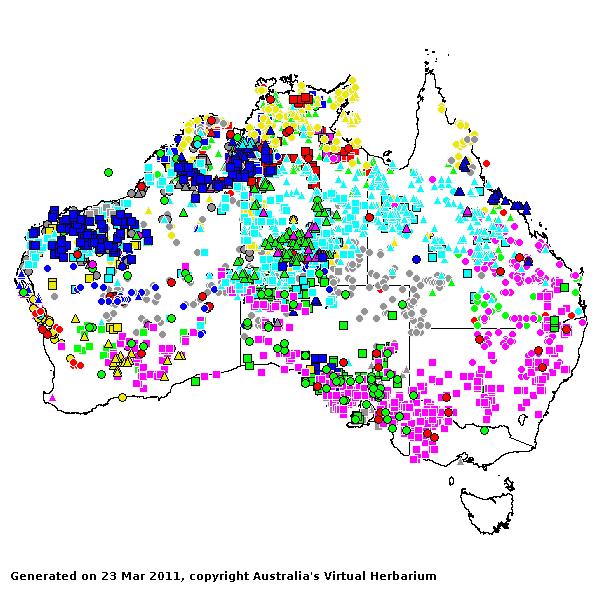Triodia Prodr.182 (1810).
Derivation:. From Latin tri (three) and odous (tooth), alluding to the three lemma lobes or teeth.
Syn: Plectrachne Henrard.
Taxonomic revisions, nomenclatural references:. N.T.Burbidge, Aust. J. Bot. 1: 121–184 (1953) and Aust. J. Bot. 8: 381–395 (1960); S.W.L.Jacobs, Telopea 4: 653–659 (1992) and Nuytsia 8: 219–221 (1992).
Key references (keys and floras):. G.Bentham, Flora Australiensis 7: 605–608 (1878) and 604 (as Triraphis); C.A.Gardner, Flora of Western Australia 1 Gramineae 63–83(1952), also Plectrachne; M.Lazarides, Flora of Central Australia 444–446 and 446–447as Plecrtachne (1981); J.C.Tothill and J.B.Hacker, Grasses of Southern Queensland 412–414 (1983) and 350–351 as Plectrachne; J.P.Jessop, Flora of South Australia 4: 1869–1872 (1986) and 1867as Plectrachne; S.W.L.Jacobs, Flora of the Kimberley Region 1206–1208 as Plectrachne and 1228–1236 (1992); B.K.Simon, Key to Australian Grasses 146–147 as Plectrachne and 170–173 (1993); S.W.L.Jacobs and K.L.McClay, Flora of New South Wales 4: 544–546 (1993); N.G.Walsh, Flora of Victoria 2:555(1994); D.Sharp and B.K.Simon, AusGrass (2002) and as Plectrachne; D.Sharp and B.K.Simon, AusGrass (2002); K.Mallet (ed.), Flora of Australia 44B: Poaceae 3: 203–256 (2005); J.P.Jessop, Grasses of South Australia 409–418 (2006); S.W.L.Jacobs, R.D.B.Whalley & D.J.B.Wheeler, Grasses of New South Wales, 4th ed, 387–388 (2008).
W.D.Clayton & S.A.Renvoize, Genera Graminum (1986), genus (308).
Native, endemic. 64 species, from arid mainland Australia. WA, NT, SA, Qld, NSW, and Vic.
Habit. Prickly perennial, tufted. Culms wiry. Leaf blades narrow, hard, woody, needle-like. Ligule a fringe of hairs.
Inflorescence. Inflorescence a single spike or paniculate, an open panicle with branches ending in single spikelets, open or contracted.
Spikelets. Spikelets laterally compressed, more than 2 flowered, with 2 or more fertile florets, solitary, subsessile to pedicelled; with naked rachilla extension. Fertile spikelets disarticulating above glumes.
Glumes. Glumes more or less equal, shorter than spikelet (to subequal), shorter than adjacent lemmas or long relative to adjacent lemmas, hairless, glabrous, awnless or awned (rarely), keeled or non-keeled. Lower glume 1–7(–20) nerved. Upper glume 1–7(–20) nerved.
Florets. Fertile florets 4–15. Lemmas becoming indurated (usually, in the body), usually incised, muticous or mucronate or awned, 3–20 nerved, hairy (usually, on the body, the lobes often glabrous), 1 keeled to not keeled. Palea relatively long, 2 nerved. Palea keels winged or wingless. Callus short, blunt. Lodicules 2. Stamens 3. Grain small, ellipsoid. Hilum short. Embryo large.
Kranz Anatomy. C4 (but the PCR arrangement very unconventional, the `sheaths' lateral-only to the main bundles, and at least in the lateral parts of the blade, draping from them to adjacent bundles, so that many PCR cells are very distant from the vascular tissue), biochemical type NAD-ME (T. scariosa).
Habitat. Extreme xerophytic. On arid, sandy or stony soils. Species of open habitats.
Classification. Chloridoideae; Triodieae.
Notes. The leaves are strongly xeromorphic being massively reinforced with sclerenchyma and having their stomata confined to deep grooves, along which the chlorenchyma occurs as narrow tracts and is greatly reduced. Despite these anatomical peculiarities the microhairs unequivocally point to an eragrostoid affinity (Clayton and Renvoize, 1986). A classificatory problem in the Trioideae has been a marked inconsistency between inflorescence and anatomical chararacters. Cladistic analysis based on molecular data shows there to be greater reliance on phylogenetic grouping based whether the leaf anotomy is 'hard' or 'soft' (Mant et al 2000).
Types Species. T. pungens R.Br.
Biogeographic Element. Clifford & Simon 1981, Simon & Jacobs 1990: Endemic.


